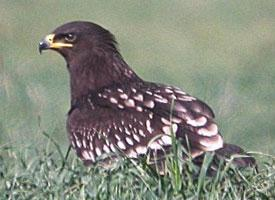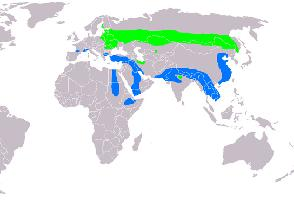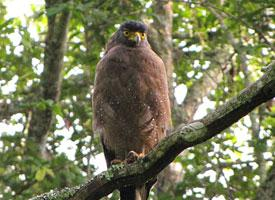
Váhy a míry
| Hmotnost | od 1600 do 3200 g |
|---|---|
| Délka rozpětí křídel | od 155 do 185 cm |
| Délka ocasu | od 60 do 70 cm |
Stav ohrožení
| Ohrožen |
Popis zvířete
The Greater Spotted Eagle (Clanga clanga), a captivating bird of prey, belongs to the Accipitridae family, which encompasses hawks, eagles, and kites among others. This majestic raptor is distinguished by its robust build, broad wings, and powerful talons, embodying the formidable essence of the eagle family. Its appearance is characterized by a blend of dark brown feathers across the majority of its body, with lighter, more variegated shades on the head and neck, and a strikingly paler, often almost creamy, underbelly. Juveniles display a more mottled appearance compared to adults, with a mix of light and dark plumage that gradually darkens with age.With a wingspan that can reach up to 160 centimeters, the Greater Spotted Eagle presents an impressive silhouette against the sky. This bird prefers a solitary existence or lives in pairs rather than forming large groups. It is primarily found in a variety of habitats ranging from open wetlands to dense forests, showing a particular preference for areas with abundant water bodies like rivers, lakes, and marshes, which are crucial for its hunting and nesting activities.
The diet of the Greater Spotted Eagle mainly consists of small mammals, birds, and occasionally fish, showcasing its versatility and adaptability in hunting. It employs a mix of hunting techniques, from soaring high to suddenly diving towards its prey or stealthily stalking it from a perch. The breeding season witnesses these eagles becoming highly territorial, with pairs engaging in spectacular aerial displays to establish dominance and attract mates.
Nesting is a critical aspect of their life cycle, with nests typically constructed high in trees or sometimes on the ground in areas devoid of tall vegetation. These structures are made from sticks and lined with softer materials. The female usually lays 1 to 3 eggs, which are incubated primarily by her while the male provides food.
The Greater Spotted Eagle has a wide but fragmented distribution, spanning across Eastern Europe, through the vast expanses of Asia, reaching as far as parts of the Middle East. Despite this extensive range, the species faces significant threats from habitat destruction, primarily due to agricultural expansion, deforestation, and wetland drainage. These factors, coupled with pollution, persecution, and climate change, have led to a decline in their population, placing them in the category of vulnerable species according to the International Union for Conservation of Nature (IUCN).
Conservation efforts are crucial to ensure the survival of the Greater Spotted Eagle. Initiatives include habitat protection and restoration, legal protection, research, and monitoring programs aimed at understanding their ecology and threats better. By safeguarding the environments they depend on and mitigating the challenges they face, there is hope for stabilizing and eventually increasing the populations of this remarkable eagle, allowing future generations to marvel at its grandeur and beauty.
Mapa výskytu

Podobná zvířata
Nové fotografie zvířat
Top 10 zvířat
- Dolphin gull (Leucophaeus scoresbii)
- Diana monkey (Cercopithecus diana)
- Stone loach (Barbatula barbatula)
- Greek tortoise (Testudo graeca)
- Moustached guenon (Cercopithecus cephus)
- Japanese macaque (Macaca fuscata)
- Galápagos tortoise (Geochelone nigra complex)
- Russian tortoise (Testudo horsfieldii)
- Galápagos penguin (Spheniscus mendiculus)
- Common flying dragon (Draco volans)


